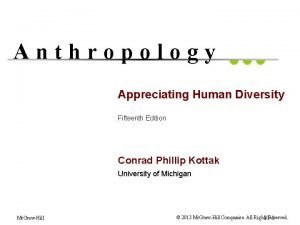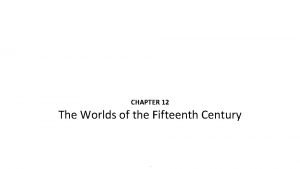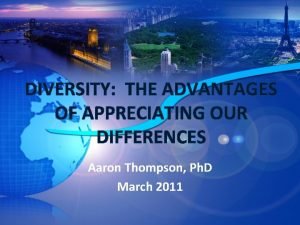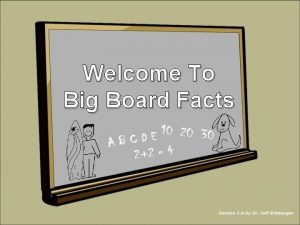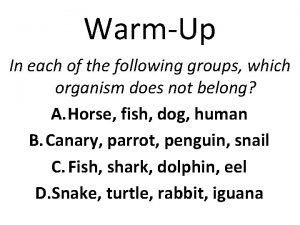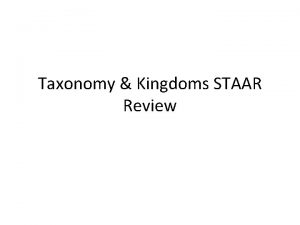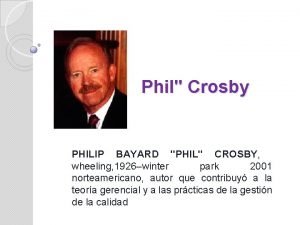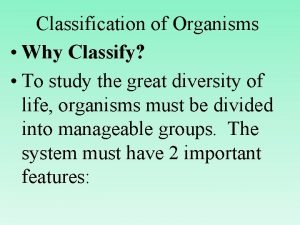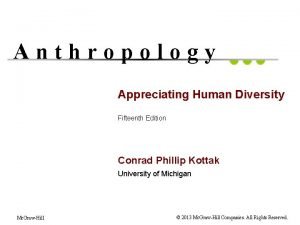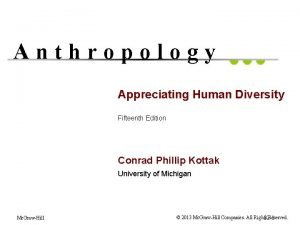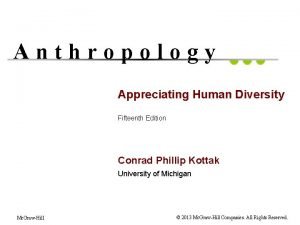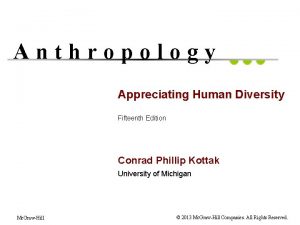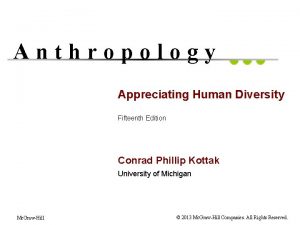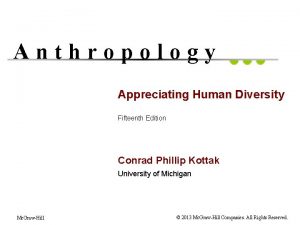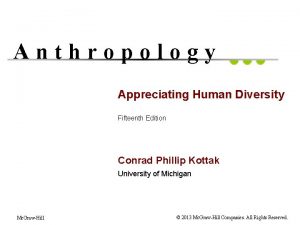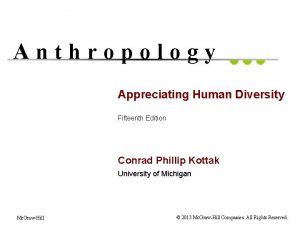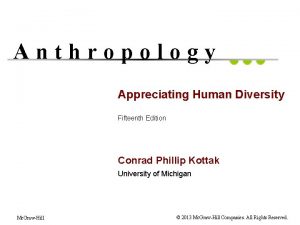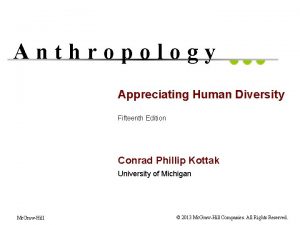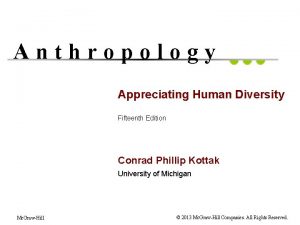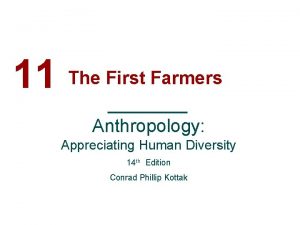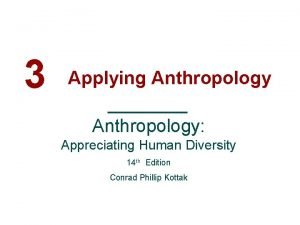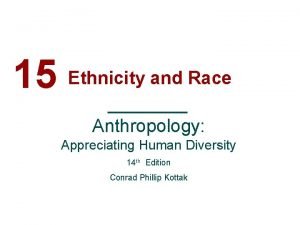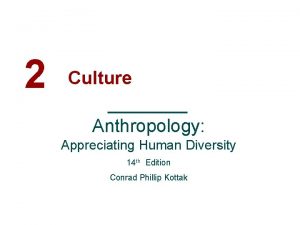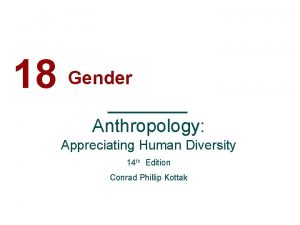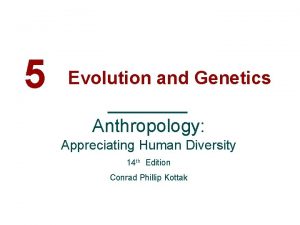Anthropology Appreciating Human Diversity Fifteenth Edition Conrad Phillip



































- Slides: 35

Anthropology Appreciating Human Diversity Fifteenth Edition Conrad Phillip Kottak University of Michigan Mc. Graw-Hill © 2013 Mc. Graw-Hill Companies. All Rights Reserved. 18 -1

C H A P T E R GENDER 18 -2

GENDER • • • Sex and Gender Recurrent Gender Patterns Gender Roles and Gender Stratification Gender in Industrial Societies Beyond Male and Female Sexual Orientation 18 -3

GENDER • How are biology and culture expressed in human sex/gender systems? • How do gender, gender roles, and gender stratification correlate with other social, economic, and political variables? • What is sexual orientation, and how do sexual practices vary cross-culturally? 18 -4

SEX AND GENDER • Women and men differ genetically • Sexual dimorphism: marked differences in male and female biology besides the primary and secondary sexual features • Sex differences are biological • Gender encompasses traits that a culture assigns to and inculcates in males and females 18 -5

SEX AND GENDER • Gender roles: tasks and activities that a culture assigns to the sexes • Gender stereotypes: oversimplified, strongly held ideas of characteristics of men and women • Gender stratification: unequal distribution of rewards between men and women, reflecting different positions in a social hierarchy • Ilongots 18 -6

Figure 18. 1: Location of Ilongots in the Philippines 18 -7

RECURRENT GENDER PATTERNS • The subsistence contributions of men and women are roughly equal cross-culturally • In domestic activities, female labor dominates • Women tend to work more hours than men do • Women are primary caregivers, but men often play a role 18 -8

RECURRENT GENDER PATTERNS • Differences in male and female reproductive strategies • Women can have only so many babies • Men mate, within and outside marriage, more than women do • Men less restricted than women are, although restrictions are equal in about half the societies studied 18 -9

Table 18. 1: Generalities in the Division of Labor by Gender, Based on Data from 185 Societies 18 -10

Table 18. 2: Time and Effort Expended on Subsistence Activities by Men and Women 18 -11

Table 18. 3: Who Does the Domestic Work? 18 -12

Table 18. 4: Who Has Final Authority over the Care, Handling, and Discipline of Infant Children (Under Four Years Old)? 18 -13

Table 18. 5: Does the Society Allow Multiple Spouses? 18 -14

Table 18. 6: Is There a Double Standard with Respect to PREMARITAL Sex? 18 -15

Table 18. 7: Is There a Double Standard with Respect to EXTRAMARITAL Sex? 18 -16

GENDER ROLES AND GENDER STRATIFICATION • Sanday: gender stratification decreased when men and women made roughly equal contributions to subsistence • Domestic-public dichotomy: strong differentiation between home and the outside world is called the domestic-public dichotomy, or the private-public contrast • Gender stratification is less developed among foragers 18 -17

GENDER ROLES AND GENDER STRATIFICATION • Greater size, strength, and mobility of men led to exclusive service in roles of hunters and warriors • Pregnancy and lactation keep women from being primary hunters in foraging societies • The Agta 18 -18

REDUCED GENDER STRATIFICATION— MATRILINEAL, MATRILOCAL SOCIETIES • Cross-cultural variation in gender status related to rules of descent and postmarital residence • Matrilineal descent: people join mother’s group at birth • Women tend to have high status in matrilineal, matrilocal societies 18 -19

MATRIARCHY • Sanday: Minangkabau a matriarchy because women are the center, origin, and foundation of the social order • Despite special position of women, matriarchy is not the equivalent of female rule 18 -20

INCREASED GENDER STRATIFICATION— PATRILINEAL-PATRILOCAL SOCIETIES • Patrilineal-patrilocal complex: male supremacy is based on patrilineality, patrilocality, and warfare • Patrilineal descent: descent traced through men • Characterizes many societies in highland Papua New Guinea 18 -21

PATRIARCHY AND VIOLENCE • Patriarchy: political system ruled by men in which women have inferior social and political status, including basic human rights • Societies that feature full-fledged patrilinealpatrilocal complex, replete with warfare and intervillage raiding, also typify patriarchy • Gender stratification typically reduced in societies in which women have prominent roles in the economy and social life 18 -22

GENDER IN INDUSTRIAL SOCIETIES • Domestic-public dichotomy influences gender stratification in industrial societies • Gender roles changing rapidly in North America • The “traditional” idea that a “woman’s place is in the home” developed among middle- and upper-class Americans as industrialism spread after 1900 18 -23

GENDER IN INDUSTRIAL SOCIETIES • Margolis: gendered work, attitudes, and beliefs have varied in response to U. S. economic needs • Changes in economy led to changes in attitudes toward and about women • Between 1970 and 2010, female percentage of American workforce rose from 38% to 47% • As women increasingly work outside the home, ideas about gender roles of males and females changed 18 -24

Table 18. 8: Cash Employment of U. S. Mothers, Wives, and Husbands, 1960– 2010 18 -25

THE FEMINIZATION OF POVERTY • Increasing representation of women and their children among America’s poorest people • Percentage of single-parent (usually femaleheaded) households increasing worldwide • Globally, households headed by women poorer than are those headed by men • One way to improve situation of poor women is to encourage them to organize 18 -26

Table 18. 9: Median Annual Income of U. S. Households by Household Type, 2009 18 -27

Table 18. 10: Percentage of Single-Parent Households, Selected Countries, 1980– 81 and 2008 18 -28

WORK AND HAPPINESS • Correlation between rankings of happiness and of women’s work outside the home • Of 13 countries with greatest female labor force participation, 10 ranked among world’s happiest 18 -29

Table 18. 11: Female Labor Force Participation by Country, 2008 18 -30

BEYOND MALE AND FEMALE • Contemporary U. S. includes individuals who self-identify using such labels as transgender, intersex, third gender, and transsexual • Transgender: social category that includes individuals who may or may not contrast biologically with ordinary males and females • Intersex: conditions involving discrepancy between external and internal genitals • Klinefelter’s syndrome • Turner syndrome 18 -31

BEYOND MALE AND FEMALE • People construct their identities in society • Many individuals with biological conditions see themselves as male or female • Self-identified transgender people tend to be individuals whose gender identity contradicts their biological sex at birth and the gender identity that society assigned to them in infancy • Fear and ignorance related to diversity in gender fuels discrimination 18 -32

SEXUAL ORIENTATION • Sexual orientation refers to person’s habitual sexual attraction to, and sexual activities with, persons of the opposite sex; heterosexuality, homosexuality, bisexuality, asexuality • Each holds different meanings for individuals and groups • In U. S. , tendency to see sexual orientation as fixed and biologically based • Sexual norms vary from culture to culture 18 -33

SEXUAL ORIENTATION • Sex acts involving people of the same sex were absent, rare, or secret in only 37 of 76 societies (Ford and Beach) • In others, various forms of same-sex sexual activity considered normal and acceptable • Sudanese Azande • Etoro of Papua New Guinea • Flexibility in sexual expression seems to be an aspect of our primate heritage 18 -34

Figure 18. 2: The Location of the Etoro, Kaluli, and Sambia in Papua New Guinea 18 -35
 Anthropology appreciating human diversity
Anthropology appreciating human diversity Performance appraisal in human resource management
Performance appraisal in human resource management Human resource management lecture chapter 1
Human resource management lecture chapter 1 University physics with modern physics fifteenth edition
University physics with modern physics fifteenth edition 13 course french classical menu
13 course french classical menu Chapter 12 worlds of the 15th century
Chapter 12 worlds of the 15th century Chapter 12 the worlds of the fifteenth century
Chapter 12 the worlds of the fifteenth century Fifteenth amendment
Fifteenth amendment Appreciating poetry notes
Appreciating poetry notes Appreciating drama
Appreciating drama Benefits of appreciating differences
Benefits of appreciating differences Why is genetic diversity important
Why is genetic diversity important Ecosystem jigsaw activity
Ecosystem jigsaw activity Using mis 10th edition
Using mis 10th edition Report
Report King phillip came over for good soup
King phillip came over for good soup King phillip came over for good soup
King phillip came over for good soup Dear king phillip came over
Dear king phillip came over 6 kingdoms chart
6 kingdoms chart Dear king phillip came over
Dear king phillip came over King philip kingdom phylum
King philip kingdom phylum Phillip crosby
Phillip crosby Phillip gilley
Phillip gilley King phillip came over from great spain
King phillip came over from great spain Deacon phillip
Deacon phillip King phillip acronym
King phillip acronym Dear king phillip came over
Dear king phillip came over Dear king phillip came over for good spaghetti
Dear king phillip came over for good spaghetti King phillip came over from great spain
King phillip came over from great spain Linnaean classification
Linnaean classification Bufonaria borisbeckeri
Bufonaria borisbeckeri Phillip of macedon
Phillip of macedon Phillip zimbardo
Phillip zimbardo Philip larkin they fuck you up
Philip larkin they fuck you up J donald phillips
J donald phillips Philip scherrer
Philip scherrer
